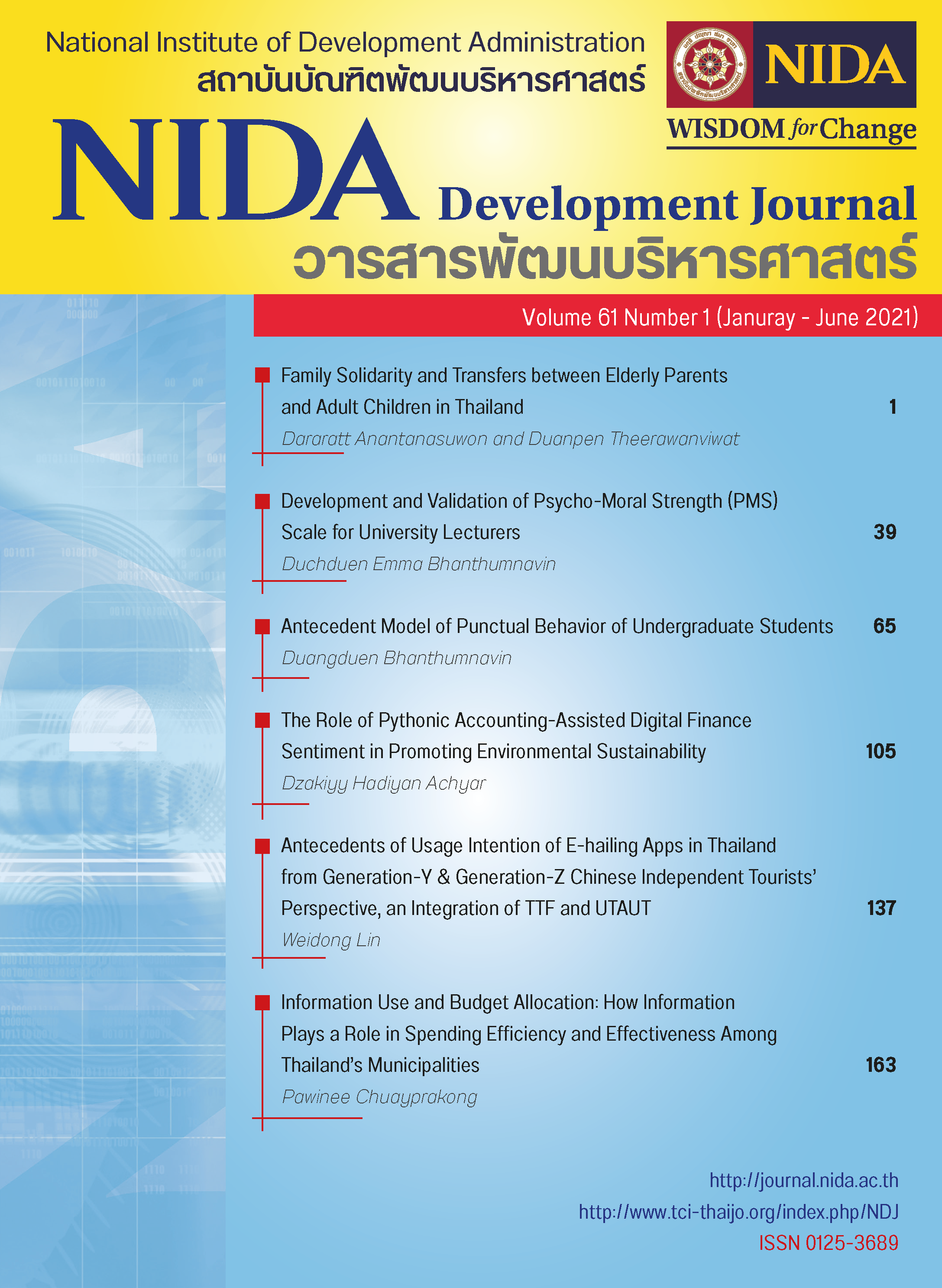Antecedents of Usage Intention of E-hailing Apps in Thailand from Generation-Y & Generation-Z Chinese Independent Tourists’ Perspective, an Integration of TTF and UTAUT
Keywords:
E-hailing, UTAUT, TTF, Usage Intention, Chinese TouristsAbstract
E-hailing has gain increased popularity in recent years for some of its advantages. However, very few extant researches examined the usage intention of e-hailing from the perspective of foreign tourists. This research examines the antecedents of usage intention of e-hailing apps by integrating TTF and UTAUT model, by using the case of Gen-Y and Gen-Z Chinese independent tourist. Online survey data were collected from Chinese respondents who has visited Thailand before the outbreak of COVID-19 pandemic or planned to visit Thailand after the end of pandemic (n = 396). The data were analysed by using Covariance Based Structural Equation Modelling (CB-SEM). The key findings showed that tourist’s usage intention of e-hailing app is positively affected by the task-technology fit, performance expectancy, effort expectancy, and social influence, which together accounted for 62% of total variation of usage intention in the integrated model. This research also confirmed a positive effect of effort expectancy on performance expectancy.
References
Andrews, J. E., Ward, H., & Yoon, J. (2021). UTAUT as a Model for Understanding Intention to Adopt AI and Related Technologies among Librarians. The Journal of Academic Librarianship, 47(6), 102437. https://doi.org/10.1016/j.acalib.2021.102437
Cimperman, M., Makovec Brenčič, M., & Trkman, P. (2016). Analyzing older users’ home telehealth services acceptance behavior—applying an Extended UTAUT model. International Journal of Medical Informatics, 90, 22-31. https://doi.org/10.1016/j.ijmedinf.2016.03.002
Davis, F. D. (1989). Perceived Usefulness, Perceived Ease of Use, and User Acceptance of Information Technology. MIS Quarterly, 13(3), 319-340. https://doi.org/10.2307/249008
Dishaw, M. T., & Strong, D. M. (1999). Extending the technology acceptance model with task–technology fit constructs. Information & Management, 36(1), 9-21. https://doi.org/10.1016/S0378-7206(98)00101-3
Faqih, K. M. S., & Jaradat, M.-I. R. M. (2021). Integrating TTF and UTAUT2 theories to investigate the adoption of augmented reality technology in education: Perspective from a developing country. Technology in Society, 67, 101787. https://doi.org/10.1016/j.techsoc.2021.101787
Goodhue, D. L., & Thompson, R. L. (1995). Task-Technology Fit and Individual Performance. MIS Quarterly, 19(2), 213-236. https://doi.org/10.2307/249689
Hartwick, J., & Barki, H. (1994). Explaining the Role of User Participation in Information System Use. Management Science, 40(4), 440-465. https://doi.org/10.1287/mnsc.40.4.440
Jiang, S.-j., Liu, X., Liu, N., & Xiang, F. (2019). Online life insurance purchasing intention: Applying the unified theory of acceptance and use of technology. Social Behavior and Personality: an international journal, 47(7), 1-13. https://doi.org/10.2224/sbp.8141
Junglas, I., Abraham, C., & Watson, R. T. (2008). Task-technology fit for mobile locatable information systems. Decision Support Systems, 45(4), 1046-1057. https://doi.org/10.1016/j.dss.2008.02.007
Khan, I. U., Hameed, Z., Yu, Y., Islam, T., Sheikh, Z., & Khan, S. U. (2018). Predicting the acceptance of MOOCs in a developing country: Application of task-technology fit model, social motivation, and self-determination theory. Telematics and Informatics, 35(4), 964-978. https://doi.org/10.1016/j.tele.2017.09.009
Ooi, K.-B., Foo, F.-E., Tan, G. W.-H., Hew, J.-J., & Leong, L.-Y. (2020). Taxi within a grab? A gender-invariant model of mobile taxi adoption. Industrial Management & Data Systems, 121(2), 312-332. https://doi-org.tue.80599.net/10.1108/IMDS-04-2020-0239
Smyth, J., Chen, H., Donzella, V., & Woodman, R. (2021). Public acceptance of driver state monitoring for automated vehicles: Applying the UTAUT framework. Transportation Research Part F: Traffic Psychology and Behaviour, 83, 179-191. https://doi.org/10.1016/j.trf.2021.10.003
Surya, A. P., Sukresna, I. M., & Mardiyono, A. (2021). Factors Affecting Intention to Use Food Order-Delivery Feature of Ride-Hailing Applications: The UTAUT Approach. International Journal of Business and Society, 22(3), 1363-1383. https://doi.org/10.33736/ijbs.4306.2021
Tarhini, A., El-Masri, M., Ali, M., & Serrano, A. (2016). Extending the UTAUT model to understand the customers’ acceptance and use of internet banking in Lebanon. Information Technology & People, 29(4), 830-849. https://doi.org/10.1108/ITP-02-2014-0034
Venkatesh, V., Morris, M. G., Davis, G. B., & Davis, F. D. (2003). User Acceptance of Information Technology: Toward a Unified View. MIS Quarterly, 27(3), 425-478. https://doi.org/10.2307/30036540
Wang, H., Tao, D., Yu, N., & Qu, X. (2020). Understanding consumer acceptance of healthcare wearable devices: An integrated model of UTAUT and TTF. International Journal of Medical Informatics, 139, 104156. https://doi.org/10.1016/j.ijmedinf.2020.104156
Wang, X., Wong, Y. D., Chen, T., & Yuen, K. F. (2021). Adoption of shopper-facing technologies under social distancing: A conceptualisation and an interplay between task-technology fit and technology trust. Computers in Human Behavior, 124, 106900. https://doi.org/10.1016/j.chb.2021.106900
Zhou, T., Lu, Y., & Wang, B. (2010). Integrating TTF and UTAUT to explain mobile banking user adoption. Computers in Human Behavior, 26(4), 760-767. https://doi.org/10.1016/j.chb.2010.01.013
Downloads
Published
How to Cite
Issue
Section
License
Copyright (c) 2023 NIDA Development Journal

This work is licensed under a Creative Commons Attribution-NonCommercial-NoDerivatives 4.0 International License.





